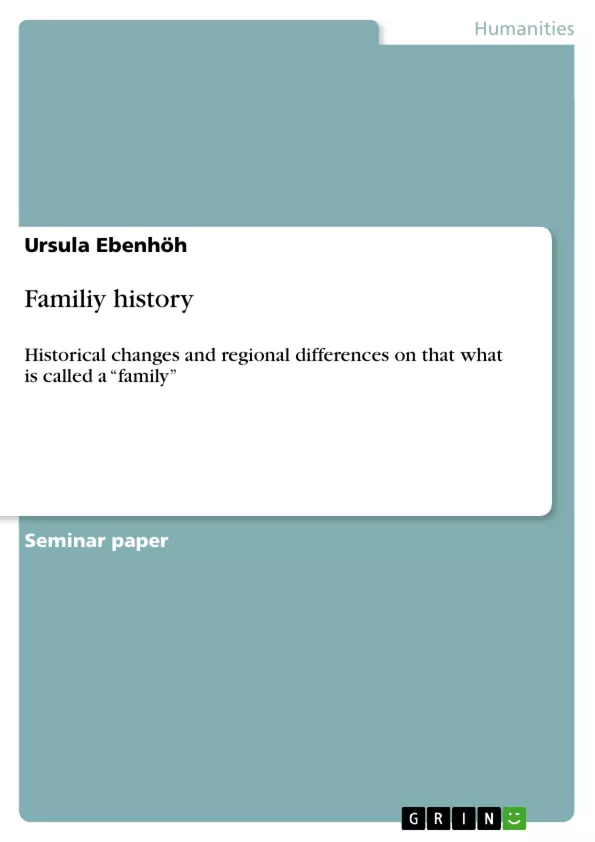This paper is written for the seminar “Family Sociology”. The theme of “Family History” I chose, covers the main topics of marriage patterns and a comparison of family and childhood issues of the past, to those of the present.
In this work I will point out the historical changes and regional differences on that what is called a “family”:
First up I will shortly illustrate the development of the European pattern from Greco-Roman times until now, and I will introduce the main marriage patterns which are spread worldwide, namely the European pattern, the Eastern European pattern and the Non-European pattern.
Then I will show how the meaning of family has changed. Not only is the structure another one compared to former times, but also has something new been created: a period called “childhood” which is different from the rest of the life course, regarding children no longer as smaller adults, but as something special.
The developments on family history go hand in hand to changes of society like the industrialization or the creation of a welfare state.
Since normative standards declined marriage is just one possibility to live together, still the most common, but steadily loosing importance. Meanwhile divorce rates have been increasing since the end of the nineteenth century and contraceptive measures have been introduced.
So obviously this, what is called a family is more flexible than ever, creating the so called “patchwork-family”, which may consist of one single parent and children, two spouses with children they have from a former relationship with another person, or even a homosexual couple with children. Nowadays there is a new tolerance for what is called a “family”. Usually talking about “family” today means referring to the “nuclear family”.
According to Berger (2002, 6) the nuclear family consisting of a married couple and a child (or children), was taken for granted in all societies of the West for the central institution of modern life, held to be superior to any other family form long into the early decades of the twentieth century.
Inhaltsverzeichnis (Table of Contents)
- Introduction
- Marriage patterns
- Marriage patterns from the past to the present.
- Regional differences between marriage habits.
- The European pattern...
- The Eastern European pattern.
- The Non-European pattern
- Recent data on marriage
- The Family.
- Changes of family life
- The "invention of childhood”.
- Conclusion
Zielsetzung und Themenschwerpunkte (Objectives and Key Themes)
This paper examines the historical development and regional variation of marriage patterns and family structures, comparing the past to the present. It explores the transformation of the concept of "family" and the emergence of "childhood" as a distinct life stage.
- Historical evolution of marriage patterns
- Regional differences in marriage habits
- Changing definitions and structures of the family
- The emergence and significance of childhood
- Impact of social changes on family life
Zusammenfassung der Kapitel (Chapter Summaries)
- Introduction: This chapter introduces the topic of family history, outlining the paper's focus on marriage patterns and changes in family structures and childhood over time. It provides a brief overview of the key areas that will be explored.
- Marriage patterns: This chapter defines marriage and explores its varied meanings and forms across cultures. It examines the evolution of European marriage patterns from the Greco-Roman era to the present, highlighting the emergence of the "European pattern" and its subsequent shifts. The chapter also explores regional variations, including the Eastern European pattern and the Non-European pattern, emphasizing the challenges of cross-cultural comparisons.
- The Family: This chapter delves into the changing nature of family life, discussing the impact of social transformations such as industrialization and the welfare state on family structures. It examines the concept of "childhood" as a distinct life stage and its implications for the understanding of family dynamics.
Schlüsselwörter (Keywords)
This paper focuses on the key concepts of marriage patterns, family structures, childhood, historical development, regional differences, and social change. It draws upon the work of scholars like Hajnal, Kuijsten, and Berger to explore the evolution and complexities of family life.
- Quote paper
- Ursula Ebenhöh (Author), 2004, Familiy history, Munich, GRIN Verlag, https://www.grin.com/document/86008



